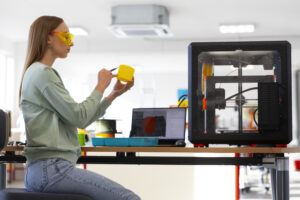Through technology and community collaboration, thousands of people are beginning to find solutions to challenges that have long left them excluded.
In small laboratories inside public hospitals in Argentina—such as Hospital Posadas—3D printers are changing lives. There, they don’t manufacture car parts or architectural tools, but something far more vital: prosthetics.
Over the past few years, 3D printing has become a global phenomenon, revolutionizing medicine. What began as a technological curiosity has evolved into a life-changing opportunity for thousands of people with amputations or congenital malformations who could not afford traditional prosthetics due to their high cost.
In many cases, the price of private-market prosthetics exceeds two or three million pesos, while the alternatives created in social clinics or foundations using 3D printers cost a fraction of that amount.
Technology for Health
3D printing enables the creation of customized prosthetics using a digital scan of the patient’s body. The process relies on open-source software and affordable materials such as biocompatible plastics. This allows for a precise anatomical fit in a much shorter time—what once took weeks of molding and assembly can now be printed in less than 48 hours.
This advance represents not only a major step toward medical inclusion but also a redefinition of access to healthcare. In Argentina and across Latin America, clinics and organizations implementing this technology often do so without direct government support.
Many of these initiatives are led by doctors, biomedical engineers, technicians, and volunteers who see innovation as a tool for social justice, alongside community workers who bring these options to the people.
In Córdoba, Rosario, and Mendoza, solidarity-based laboratories are already combining design, engineering, and medicine in spaces that offer free access. Many of these entities collaborate with universities and technology centers to refine designs and ensure product quality.
One of the most recognized initiatives is Atomic Lab, founded in 2011 by Argentine inventor Gino Tubaro. His project, known as “Mano 3D” (3D Hand), provides free prosthetics to children and adults across the country and has been replicated in both public and private hospitals.
In recent years, its open-collaboration model has enabled medical communities to join in and multiply its impact.
How 3D-Printed Prosthetics Are Made
The development process combines technical precision with emotional support. It begins with a 3D scan of the affected limb or area. Specialists then design the prosthetic using open-source digital programs, and the piece is printed layer by layer before being personally adjusted for the patient.
While 3D-printed prosthetics do not yet replace high-end models used in complex rehabilitation, they offer functional, aesthetic, and affordable solutions for those without medical coverage or sufficient resources.
Moreover, this technology allows for easy repairs, adjustments, and upgrades without relying on costly suppliers.
A New Model of Health Innovation
Many of the organizations producing these prosthetics operate thanks to private donations, community fundraising, or partnerships with tech companies. In some cases, former patients become volunteers or donate printers after regaining their autonomy.
This model has also drawn interest from international foundations promoting inclusive development, such as the Siemens Foundation, UNICEF, and USAID, which fund projects across Latin America that combine 3D printing with professional training in healthcare and technology.
The use of 3D printing in medicine represents a profound social transformation, paving the way for a healthcare system that is not dependent on the state but built on collaboration, creativity, and solidarity. It is not merely about manufacturing prosthetics—it is about reimagining medicine from a deeply human perspective.
Each prosthetic delivered free of charge is more than a molded piece of plastic—it is a life-changing device that proves technology can be used to repair, connect, and heal.
As hospital printers continue their work, thousands of people are regaining movement and autonomy through prosthetics that open new paths. The clinics that 3D print do more than restore limbs—they restore dignity.
This new landscape is the tangible result of a grassroots revolution, born from small spaces and driven by those who believe that health must never be a privilege, but a right that demands a response.



